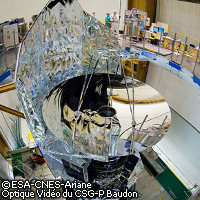ESA's Herschel and Planck lift off and talk back
On 14 May, the advanced space observatories Herschel and Planck were successfully launched into space and sent their first radio signals to Earth. The cutting-edge spacecraft took off from the European Space Agency (ESA) spaceport in Kourou, French Guiana and separated from an Ariane 5 launcher at 1,150 and 1,700 kilometres above the Earth. Their broadcast signals were received by ESA's 35-metre deep-space antenna at New Norcia in Australia. The two satellites will operate independently, observing the cosmos in unprecedented detail. Herschel carries the largest, most powerful infrared telescope ever flown in space: its 3.5-metre-diameter mirror is approximately one and a half times larger than that of the Hubble Space Telescope. Planck will study the cosmic microwave background (CMB): relic radiation from the Big Bang. The 3.4-tonne Herschel carries two instruments that operate as both cameras and imaging spectrometers: PACS (Photoconductor Array Camera and Spectrometer) and SPIRE (Spectral and Photometric Imaging Receiver). Also on board is a spectrometer with extremely high resolution, HIFI (Heterodyne Instrument for the Far Infrared). A sophisticated cryogenic system (a cryostat) cools their detectors to temperatures close to absolute zero. Together, these instruments will enable Herschel to operate at wavelengths that have until now been unobserved, and to capture data images in extreme detail. Its observations can cover the entire range, from far-infrared to sub-millimetre wavelengths; it is capable of 'seeing' almost 20 times more light than earlier infrared space telescopes, allowing it to observe regions of space that are otherwise invisible. Herschel will begin working two weeks from launch, when it will be more than 1 million kilometres from Earth. It will reach its destination orbit, around 1.5 million kilometres from Earth, around 100 days after launch. It will operate for a minimum of three years, or until the cryostat runs out of helium (this could be around four years from now). Herschel has several objectives, both within our Galaxy and without. Within the Milky Way, it will study Solar System objects such as asteroids; the process of star and planet formation; and dust and gas in our and neighbouring galaxies. Beyond our galaxy it will, among other things, 'resolve the infrared cosmic background and characterise the sources'. The global scientific community will be able to use the observatory for around two thirds of its observing time. Herschel operates autonomously and will send its data back to Earth for three hours a day. The Planck observatory's goal is to measure tiny fluctuations in the CMB, which will enable it to give lead to give us a highly detailed picture of the Universe when it was only 380,000 years old. The 1.9-tonne Planck will cover nine wavelength bands, ranging from one centimetre to one third of a millimetre (from microwave sized to the very far infrared). It carries a 1.9 x 1.5-metre telescope, with a 1.5-metre aperture. Two sensitive radio detectors, on the Low Frequency Instrument and the High Frequency Instrument, will collect radiation, measuring CMB temperature over an incredibly large area. The instruments will seek out regions that are very slightly warmer or colder than average. As on Herschel, a cryostat keeps the detectors at temperatures close to absolute zero. Planck has a lot to do. Its primary goal is 'to determine the large-scale properties of the Universe with high precision'. It is also set to investigate the nature of dark matter and, if possible, to quantify it. Planck's other objectives are to test theories of 'inflation' (a period of rapid expansion that gave birth to the Universe), to search for 'primordial gravitational waves' that may have been present during inflation, and to search for defects in space. It will also study the origin of the structures we see in the Universe today as well as our and other galaxies in the microwave, which will allow it to map the large-scale distribution of cold dust along the spiral arms. Planck will gather data over the course of 15 months, which ESA believes should be enough time for it to survey the whole sky twice. The mission could be extended for a year. Mission control teams will receive telemetry from the Herschel observatory via New Norcia, and from Planck via ESA's antenna at Perth, Australia. As soon as the data are received, engineers will determine and fine-tune the trajectory of each satellite.
Countries
French Guiana



